fold seats AUDI A5 COUPE 2011 Owners Manual
[x] Cancel search | Manufacturer: AUDI, Model Year: 2011, Model line: A5 COUPE, Model: AUDI A5 COUPE 2011Pages: 362, PDF Size: 84.88 MB
Page 78 of 362

Seats and storage
Applies to veh icles : w ith manua lly adj ustable seats
Easy entry function
The easy entry function makes it easier for the rear
passengers to enter and leave the vehicle .
Fig. 69 Driver's seat:
La tch on the seatba ck
Tilt the seatback forward and push the front
seats forward
- Lift the latch=:> fig. 69.
- Hold the latch and tilt the seatback forward.
- Release the latch and push the seat forward.
Push the front seats back and fold the
seatback up
- Push the front seat back before you fold the seat backs up.
Otherwise the seat cannot be pushed back to its original position .
& WARNING
Always be certain that the front seats are upright and securely
latched when you drive.•
Power front seat adjustment
Ap plies to vehicl es: wit h po wer adjusta ble se at s
Seat adjustment controls
The operating logic for the switches corresponds to the
construction and function of the seat .
.,
~ 9
"' "' m
Fig. 70 Front seat:
Controls for seat
adj ustme nt
The switches to adjust the seat cushion and the seatback correspond
to the layout, the design and the funct ion of the seat. The seats are
adjusted by moving the switches following this logi c.
Controls
@ Lumbar support*
@ Seat adjustment
© Seat back and head restraint height adjustment*
@ Upper thigh support* •
Page 80 of 362

Seats and storage
Applie s to veh icles : wi th powe r ad justa ble seats
Easy entry function
The easy entry function makes it easier for the rear
passengers to enter and leave the vehicle.
Fig . 71 Driv er's se at:
C o nt rol s for e asy entry
a ss ist
Folding down the front seat backs
- Liftthel atc h=>fig.71 .
- Tilt the s eatba ck fo rward .
Moving the front seats forward
-Press and hold the switc h@ until t he seat has reached t he
desired position.
Moving front seats back
- Press an d ho ld t he switc h@ unti l the s eat has r eached t he
des ired posi tion . The seat stop s au to matically when it has
reached its starting posit io n again.
To make it eas ier to enter and leave t he rear seat, t he sea tbacks of the
front seats can be folded forward and the head restraints a re a uto
matically lowe red . At the same time, the front seats can be moved
forward and b ack . When the front seats a
re moved forward, their original pos it io n is
sto red. Whe n it i s move d back, t he se at a utoma ticall y sto ps in t his
position . To move the seat eve n further back, you have to release the
switch ® and reactivate it.
T he head res tra ints from the fron t seats , dependi ng on the seat
height that has been set, are automat ically ret racted when the seat
backs are folded down . T hey retu rn to t heir o riginal position again
when the sea tbacks for the fron t sea ts are raised.
[ i ] Tips
Wi th the driver's or passenge r's door closed, the correspond ing
switch to move the seat is inoperative .•
Seat memory
Ap plies to veh icles : w ith sea t mem ory
Memory for driver's seat
The seat adjustment settings for two drivers can be
stored using the memory butt ons in th e driver's door .
Fig. 72 Driver 's door :
Seat m em ory
In addit ion to the setting for the driver's sea t, the exterio r rea r view
m irror set ting can be stored and re called throug h sea t memory if t he
vehicle is p roperly equippe d.
~
Page 83 of 362
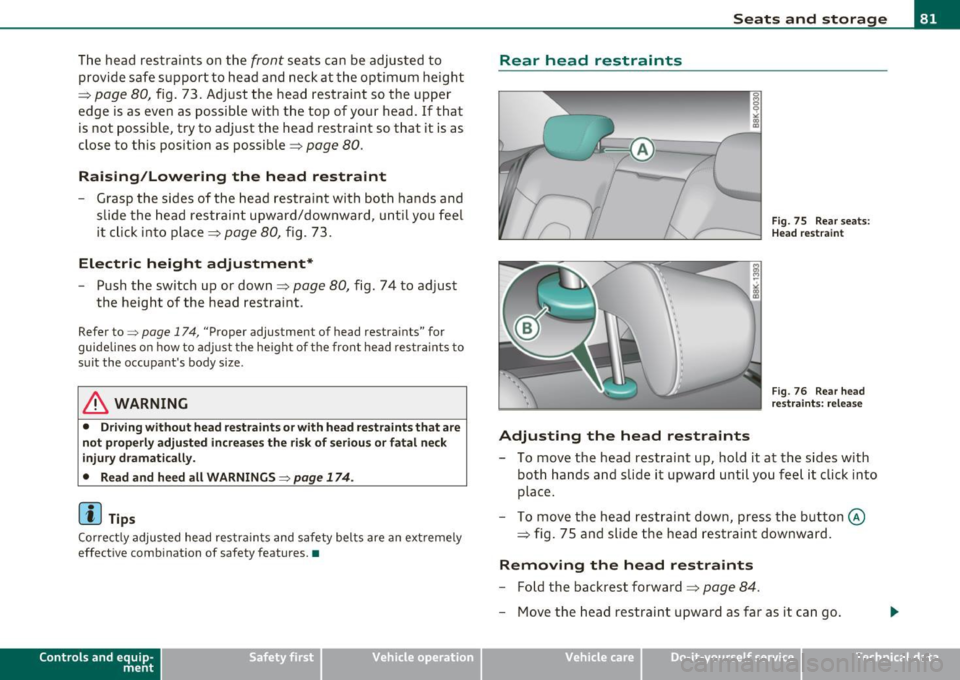
The head restraints on the front seats can be adjusted to
provide safe support to head and neck at the optimum height
=> page 80, fig. 73. Adjust the head restraint so the upper
edge is as even as possible with the top of your head. If that
is not possible, try to adjust the head restraint so that it is as
close to this position as possible=>
page 80.
Raising/Lowering the head restraint
-Grasp the sides of the head restraint with both hands and
slide the head restraint upward/downward, until you feel
it click into place=>
page 80, fig. 73.
Electric height adjustment*
Push the switch up or down=> page 80, fig. 74 to adjust
the height of the head restraint.
Refer to=> page 174, "Proper adjustment of head restraints" for
guidelines on how to adjust the height of the front head restraints to
suit the occupant's body size.
& WARNING
• Driving without head restraints or with head restraints that are
not properly adjusted increases the risk of serious or fatal neck
injury dramatically.
• Read and heed all WARNINGS=>
page 174.
(I) Tips
Correctly adjusted head restraints and safety belts are an extremely
effective combination of safety features. •
Contro ls a nd e quip
m en t Vehicle
OP-eration
Seats and storage
Rear head restraints
Adjusting the head restraints
Fig. 75 Rear seats:
Head restraint
Fig. 76 Rear head
restraints: release
- To move the head restraint up, hold it at the sides with
both hands and slide it upward until you feel it click into
place.
- To move the head restraint down, press the button ©
=> fig. 75 and slide the head restraint downward.
Removing the head restraints
- Fold the backrest forward=> page 84.
-Move the head restraint upward as far as it can go.
Vehicle care Do-it-yourselt service iTechnical data
Page 84 of 362

Seats and storage
-Press the release@=:> page 81, fig. 76 with the mechan
ical key=:>
page 44 and the button @=:> page 81, fig. 75.
Pull the head restraint out of the backrest at the same
time=:> &.
Installing the head restraints
-Slide the posts on the head restraint down into the guides
until you feel the posts click into place .
Press the button@=:>
page 81, fig. 75 and slide the head
restraint all the way down. You should not be able to pull
the head restraint out of the backrest.
So that the driver can have a better view to the rear, the head
restraints should be pushed down completely when the rear seats are
not occupied.
& WARNING
• Only remove the rear seat head restraints when necessary in
order to install a child seat. Install the head restraint again imme
diately once the child seat is removed. Driving without head
restraints or with head restraints that are not properly adjusted
increases the risk of serious or fatal neck injury dramatically.
• Read and heed all WARNINGS~
page 174.
(I) Tips
Correctly adjusted head restraints and safety belts are an extremely
effective combination of safety features.•
Center armrest
The center armrest can be adjusted to several levels.
Adjusting the center armrest
Fig. 77 Armrest
between the
dr iver's/front
passenger's seats.
-To adjust the angle, raise the armrest from the starting
position detent by detent =:> fig. 77.
- To bring the armrest back into the starting position, raise
it out of the top detent and fold it back down.
The armrest can slide forward and back. •
Page 86 of 362
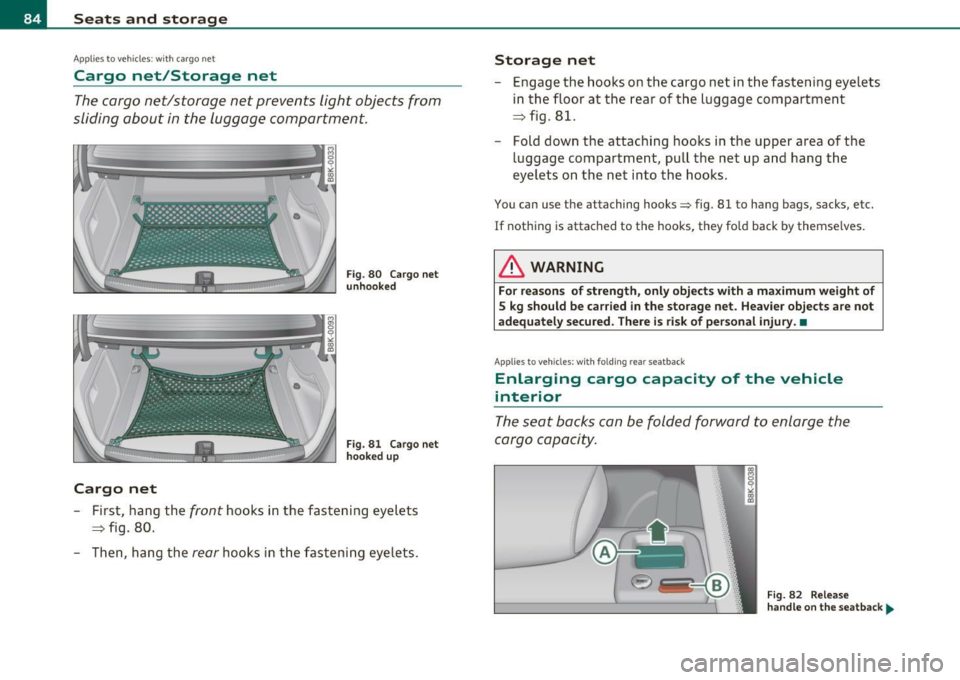
Seats and storage
Applie s to vehicles : w ith carg o net
Cargo net/Storage net
The cargo net/storage net prevents light objects from
sliding about in the luggage compartment.
Cargo net
Fig. 80 Cargo net
unhooked
Fig. 81 Cargo net
hooked up
Fir st, hang the front hooks in the fastening eyelets
=> fig. 80.
Then, hang the
rear hooks in the fastening eyelets.
Storage net
- Engage the hooks on the cargo net in the fastening eyelets
in the floor at the rear of the luggage compartment
=> fig. 81.
- Fold down the attaching hooks in the upper area of the
luggage compar tment, pull the net up and hang the
eye lets on the net into the hooks.
You can use the attaching hooks:::> fig. 81 to hang bags, sacks, etc.
If nothing is attached to the hooks, th ey fo ld back by themselves .
& WARNING
For reasons of strength, only objects with a maximum weight of
5 kg should be carried in the storage net. Heavier objects are not
adequately secured . There is risk of personal injury. •
Applies to vehicles: with fold ing rear seatback
Enlarging cargo capacity of the vehicle
interior
The seat backs can be folded forward to enlarge the
cargo capacity.
Fig. 82 Release
handle on the seatback ...
Page 87 of 362

Folding the seatback forward
-When you pull the release lever @=> page 84, fig. 82 in
the direction of the a rrow, the sa fe ty knob ® pops out far
eno ug h f or th e re d m ark ing on kn ob to be visi ble .
- Fold t he seatbac k forward.
Raising the seatback
- Raise th e se atb ac k un til it is s ecure ly lat ch ed => & . W hen
yo u ca n no lo nge r se e the red mark on the safe ty knob ®,
th e se at is lat ched.
& WARNING
• The backrest must always be securely latched so that the safety
belt of the center seating position can work properly to help
protect the occupant .
• The backrest must be securely latched
in pos ition so that no
items contained in the luggage compartment can slide forward
upon sudden braking.
• Always check whether the latch is fully engaged by pulling the
sea tback forward.
• Never allow safety belt s to become damaged by being caught
in door or seat hardware .
• Torn or frayed safety belts can tear and damaged belt hardware
can b reak in a crash. Inspect the belts periodically . Belts showing
damage to webbing , bindings , buckles, or retractor s mu st be
replaced.
0 Note
• If you move the front seat back when the rear seat backrest is
f olded forward, you co uld damage the hea d r estrain ts on the re ar
seat.
Con tro ls a nd e quip
m en t Vehicle
OP-eration
Seats and storage
• Slide the belt guide on the outs ide safety be lt all the way up
before folding the backrest b ack fo rwar d. M ake s ure the se at bel t is
not p inc hed or damaged when the rear seat backrest if folded back .
Other o bjects should be removed from the rear seat be nch to protect
the seatback from damage .•
Ap plies to vehicles: w it h fol ding rea r seatbac k
Enlarging cargo capacity of the Luggage
compartment
T he seat bac ks can be folded forward to enlarge the
c a rgo capacity.
-- ---
------=
Vehicle care
0 Fig . 83 Re lea se l eve r
in cargo a rea
F ig .
84 Safety knob ~
Do-it-yourselt service iTechnical data
Page 88 of 362
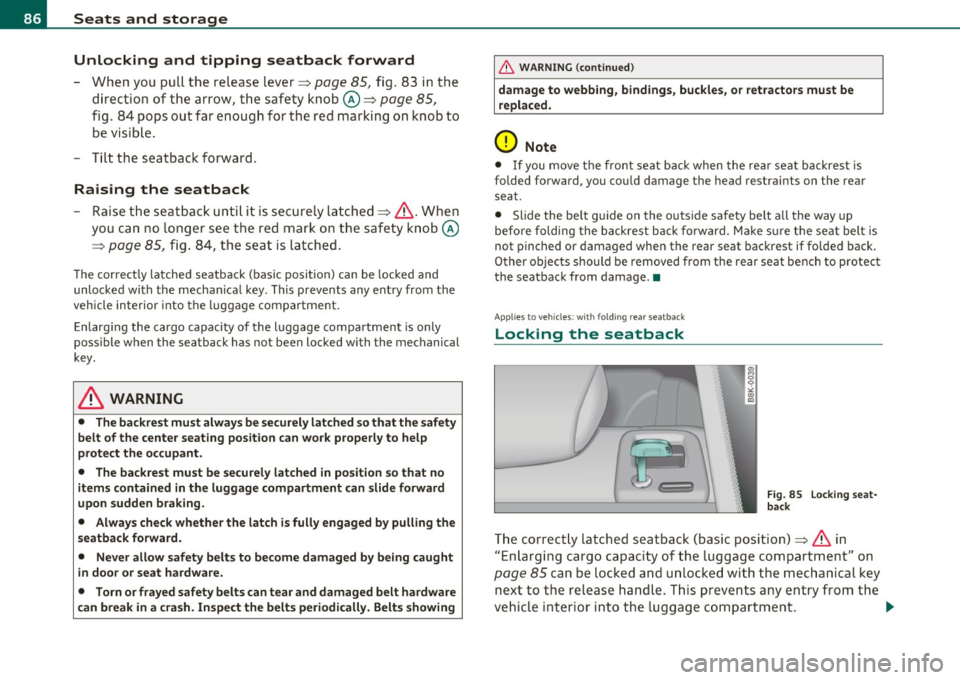
Seats and storage Unlocking and tipping seatback forward
- When you pull the release lever~ page 85, fig. 83 in the
direction of the arrow, the safety knob©~
page 85,
fig. 84 pops out far enough for the red marking on knob to
be visible.
- Tilt the seatback forward.
Raising the seatback
-Raise the seatback until it is securely latched~& . When
you can no longer see the red mark on the safety knob©
~ page 85, fig. 84, the seat is latched.
The correctly latched seatback (basic position) can be locked and
unlocked with the mechanical key . This prevents any entry from the
vehicle interior into the luggage compartment.
Enlarging the cargo capacity of the luggage compartment is only
possible when the seatback has not been locked with the mechanical
key.
& WARNING
• The backrest must always be securely latched so that the safety
belt of the center seating position can work properly to help
protect the occupant.
• The backrest must be securely latched in position so that no
items contained in the luggage compartment can slide forward
upon sudden braking.
• Always check whether the latch is fully engaged by pulling the
seatback forward.
• Never allow safety belts to become damaged by being caught
in door or seat hardware.
• Torn or frayed safety belts can tear and damaged belt hardware
can break in a crash. Inspect the belts periodically. Belts showing
& WARNING (continued)
damage to webbing, bindings, buckles, or retractors must be
replaced.
0 Note
• If you move the front seat back when the rear seat backrest is
folded forward, you cou ld damage the head restraints on the rear
seat.
• Slide the be lt guide on the outs ide safety be lt all the way up
before folding the backrest back forward. Make sure the seat belt is
not pinched or damaged when the rear seat backrest if folded back.
Other objects should be removed from the rear seat bench to protect
the seatback from damage. •
Applie s to v eh icl es: wi th fol ding rear se a tback
Locking the seatback
~. Fig. SS Locking seat
back
The correctly latched seatback (basic position) ~ & in
"Enlarging cargo capacity of the luggage compartment" on
page 85 can be locked and unlocked with the mechanical key
next to the release handle. This prevents any entry from the
vehicle interior into the luggage compartment.
Page 89 of 362

-Turn th e m echanical key=> fig . 85 to the right to lock th e
seatback .
- Tur n the mechanical key to the left to
unlock t h e seatback.
Parcel shelf
The par cel shelf behind the rear seatback can be used to
carry li ght items of clo thing .
& WARNING
No hea vy o r hard objects should be placed on the parcel shelf. They
are a haza rd to the vehicl e occupant s during sudden braking . The
is a risk of injur y.
0 Note
Please make sure that the heating wires for the rear window defogger
are not damage by abrasive objects .
[I] Tips
To ensure problem-free ventilation, the ventilation s lots between the
re ar win dow and the parcel shelf must not be cove red .•
Con tro ls a nd e quip
m en t Vehicle
OP-eration
Seats and storage
Applies to veh icles : w ith ski sack
Ski sack
The ski sack can be carried in th e interior with the help of
the pass-through.
Fig. 86 I n the rea r
s ea t bench : Open ing
t h e pa ss-t hr ough
Opening the trunk pass-through
- Fold the cente r armrest in the rear forward and out.
- Pull the rele ase han dle => fig . 86 -Arrow- an d fold down
th e c ove r of the pass -through i n the vehic le int erior.
- Open the rea r lid.
- Push the ski sack through the opening from the luggage
compartment.
- Secure the s ki sack =>
page 88 .
Closing the trunk pass-through
-Open the rea r lid.
- Remove the ski sack from the trunk pass -through .
- Push t he pass-through cover up inside the vehicle until it
latches .
- Raise t he cen ter armrest in the vehicle again .
Vehicle care Do-it-yourselt service Technical data
Page 175 of 362
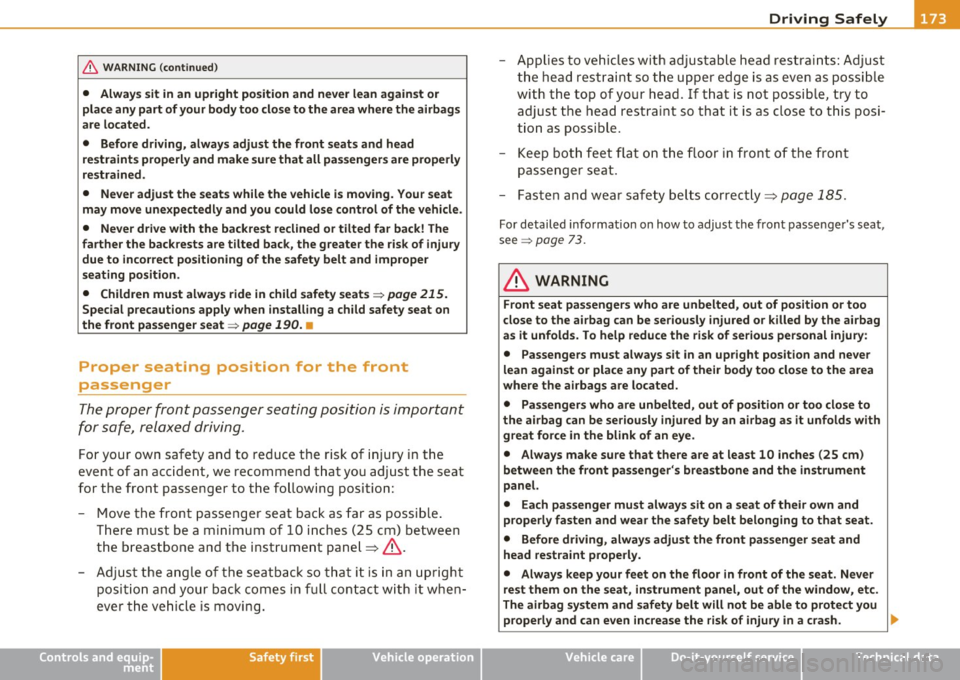
Driving Safely ---------------------" ~'---
& WARNING (continued)
• Always sit in an upright position and never lean against or
place any part of your body too close to the area where the airbags
are located.
• Before driving, always adjust the front seats and head
restraints properly and make sure that all passengers are properly
restrained.
• Never adjust the seats while the vehicle is moving. Your seat
may move unexpectedly and you could lose control of the vehicle.
• Never drive with the backrest reclined or tilted far back! The
farther the backrests are tilted back, the greater the risk of injury
due to incorrect positioning of the safety belt and improper
seating position.
• Children must always ride in child safety seats~
page 215.
Special precautions apply when installing a child safety seat on
the front passenger seat~
page 190. •
Proper seating position for the front
passenger
The proper front passenger seating position is important
for safe, relaxed driving .
For your own safety and to reduce the risk of injury in the
event of an accident, we recommend that you adjust the seat
for the front passenger to the following position:
- Move the front passenger seat back as far as possible.
There must be a minimum of 10 inches (25 cm) between
the breastbone and the instrument panel~&.
- Adjust the angle of the seatback so that it is in an upright
position and your back comes in full contact with it when
ever the vehicle is moving.
Controls and equip
ment Safety first Vehicle operation
-
Applies to vehicles with adjustable head restraints: Adjust
the head restraint so the upper edge is as even as possible
with the top of your head . If that is not possible, try to
adjust the head restraint so that it is as close to this posi
tion as possible.
- Keep both feet flat on the floor in front of the front
passenger seat.
- Fasten and wear safety belts correctly~
page 185.
For detailed information on how to adjust the front passenger's seat,
see ~
page 73.
& WARNING
Front seat passengers who are unbelted, out of position or too
close to the airbag can be seriously injured or killed by the airbag
as it unfolds. To help reduce the risk of serious personal injury:
• Passengers must always sit in an upright position and never
lean against or place any part of their body too close to the area
where the airbags are located.
• Passengers who are unbelted, out of position or too close to
the airbag can be seriously injured by an airbag as it unfolds with great force in the blink of an eye.
• Always make sure that there are at least 10 inches (25 cm)
between the front passenger's breastbone and the instrument
panel.
• Each passenger must always sit on a seat of their own and
properly fasten and wear the safety belt belonging to that seat.
• Before driving, always adjust the front passenger seat and
head restraint properly.
• Always keep your feet on the floor in front of the seat. Never
rest them on the seat, instrument panel, out of the window, etc.
The airbag system and safety belt will not be able to protect you
properly and can even increase the risk of injury in a crash. .,
Vehicle care Do-it-yourself service Technical data
Page 201 of 362
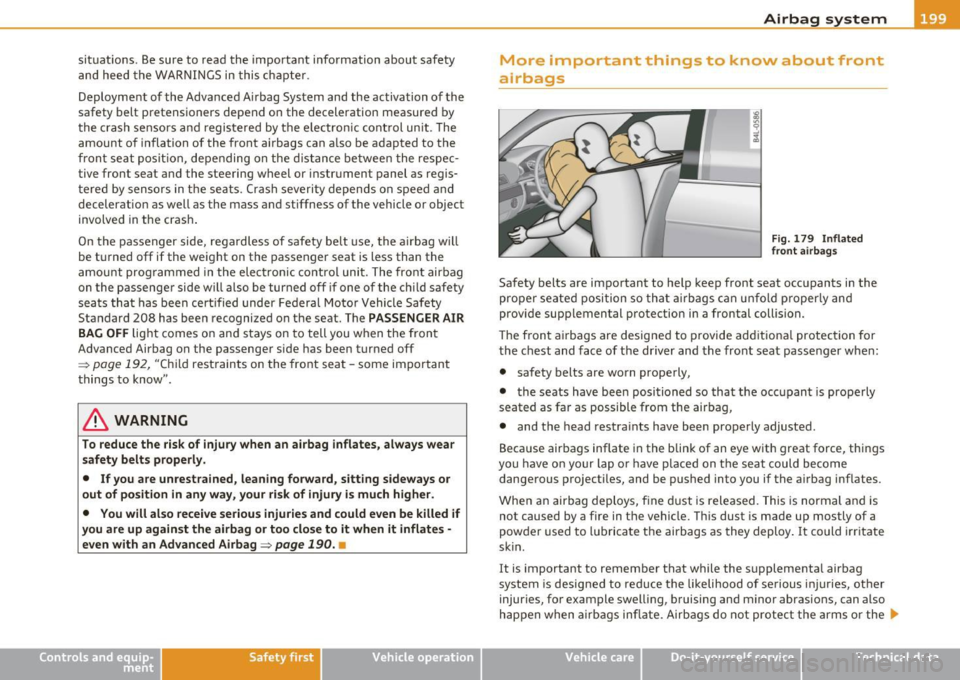
situations. Be sure to read the important information about safety
and heed the WARNINGS in this chapter.
Deployment of the Advanced A irbag System and the activation of the
safety belt pretensioners depend on the deceleration measured by
the crash sensors and registered by the electron ic control unit. T he
amount of inflation of the front airbags can a lso be adapted to the
front seat position, depending on the distance between the respec
tive front seat and the steering wheel or instrument panel as regis
tered by sensors in the seats. Crash severity depends on speed and
deceleration as well as the mass and stiffness of the vehicle or object
involved in the crash .
On the passenger side, regardless of safety belt use, the air bag w ill
be turned off if the weight on the passenger seat is less than the
amount programm ed in the electronic control unit . The front airbag
on the passenger side will also be turned off if one of the chi ld safety
seats that has been certified under Federal Motor Vehicle Safety
Standard 208 has been recognized on the seat. The
PASSENGER AIR
BAG OFF
light comes on and stays on to tell you when the front
Advanced Airbag on the passenger side has been turned off
=> page 192, "Child rest raints on the front seat -some important
things to know".
& WARNING
To reduce the risk of injury when an airbag inflates, always wear
safety belts properly.
• If you are unrestrained, leaning forward, sitting sideways or
out of position in any way, your risk of injury is much higher .
• You will also receive serious injuries and could even be killed if
you are up against the airbag or too close to it when it inflates •
even with an Advanced Airbag=>
page 190. •
Safety first Vehicle OP-eration
Airbag system
More important things to know about front
airbags
Fig. 17 9 Inflated
front airbags
Safety belts are important to help keep front seat occupants in the
proper seated position so that airbags can unfold properly and
prov ide supplemental protection in a frontal collision.
Th e front airbags are designed to provide additiona l protection for
the chest and face of the driver and the front seat passenger when:
• safety belts are worn properly,
• the seats have been positioned so that the occupant is properly
seated as far as possible from the airbag ,
• and the head restraints have been properly adjusted .
Because airbags inflate in the blink of an eye with great force, things
you have on your lap o r have placed on the seat could become
dangerous projectiles, and be pushed into you if the airbag inflates.
When an airbag deploys, fine dust is released. This is normal and is
not caused by a fire in the vehicle. This dust is made up mostly of a
powder used to lubricate the airbags as they deploy .
It could irritate
skin.
It is important to remember that while the supplemental airbag
system is desig ned to reduce the likelihood of serious injur ies, other
injuries, for example swell ing, bruising and m inor abrasions, can also
happen when airbags inflate. Airbags do not protect the arms or the •
Vehicle care Do-it-yourselt service iTechnical data